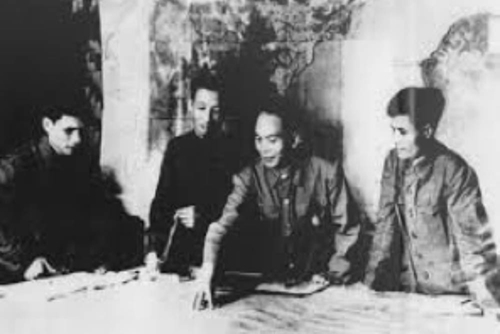* In the book “Histoire de la guerre d'Indochine” (History of the Indochina War) by Y. Gras, the author stated that the French leadership in the battle of Dien Bien Phu was influenced by concerns about how to limit irretrievable losses. The French Foreign Legion and paratroops had only 300 personnel left. The artillery force had ammunition only enough for a night of fighting.
The French side claimed that their fortifications would not be destroyed, as after being reinforced by two battalions, the enemy had more than 10,000 troops in 30 positions on the paddy field. They tried to protect the remaining key defense areas, including Hill A1 and part of Hill C1. The artillery force became stronger. The enemy still maintained absolute superiority in the air. However, our troops tried to limit their air support, forcing the enemy to conduct parachute drops at high altitudes.
    |
 |
|
General Vo Nguyen Giap (second from right) discussing combat tactics (A filed photo) |
* In Northern Vietnam, Division 312 ordered Regiment 165 to attack Fortification 105 on the afternoon of April 3. The attack lasted until the morning of the next day. Our troops occupied two-thirds of the fortification but only managed to wipe out part of their troops. The next morning, De Castries sent a battalion and five tanks to counterattack and occupy the whole fortification.
After five days of fighting in the second wave of attacks, our troops obtained significant achievements. In Eastern Dien Bien Phu, our troops occupied four key mountains; however, the enemy still seized Hill A1. In the Western area, our troops retook height 106. The enemy’s occupation was much narrowed, but our troops also suffered heavy losses. Especially, we could not capture Fortification A1.
    |
 |
|
Our troops digging trenches and secretly approaching deep into the enemy's position (A filed photo: VNA) |
Learning about this situation, the campaign’s command exchanged views and decided to send another unit to replace the current regiment, showing a high determination to destroy this fortification.
Several sources of information revealed that French troops on Hill A1 suffered severe losses. They contacted the commanders in Muong Thanh, called for urgent help and asked for reinforcements. The enemy was still able to hold on this position as there was an underground tunnel under the top of the hill.
After taking the place of Regiment 174, Hung Sinh, Commanding Officer of Regiment 102, grasped the situation and led the Vietnamese troops. However, our troops had not found measures to destroy the enemy's tunnel yet. It was a large tunnel built by the enemy before and was reinforced after they occupied Dien Bien Phu.
On the afternoon of April 3, Hung Sinh reported to higher levels that after many days of intense fighting, our troops secured occupied positions; however, the troops got rather tired. Therefore, the regiment asked for reinforcements to annihilate the enemy’s tunnel.
Also in this afternoon, Major General Hoang Van Thai, Chief of Staff of Dien Bien Phu Front, summarized four days of fighting on Hill A1 and reported to higher levels. After exchanging views, General Vo Nguyen Giap ordered the units to temporarily stop fighting from April 4, secure the occupied positions and stay ready to attack the enemy until further orders.
Translated by Quynh Oanh